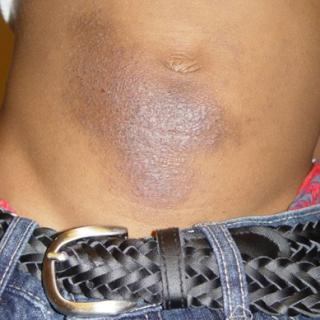If you’re preparing for the United States Medical Licensing Examination® (USMLE®) Step 3 exam, you might want to know which questions are most often missed by test-prep takers. Check out this example from Kaplan Medical, and read an expert explanation of the answer. Also check out all posts in this series.
A worried mother brings in her 7-year-old son, who recently returned from summer camp with a new "itchy" rash on and around his umbilicus (shown below). He is not aware of any tick or insect bites and has no known allergies.
His temperature is 37.0 ºC (98.6 ºF). On examination, there is a well-demarcated, erythematous, circular plaque with numerous small vesicles at the periumbilical area. The surrounding skin is normal without xerosis. Oral and conjunctival mucosa, as well as the remainder of the cutaneous examination, is unremarkable. The mother is anxious about the lesions and worries that her son may have gotten an infection, and she wants you to give the child antibiotics.
Which of the following is the most appropriate next step in management?
A. Prescribe doxycycline and reassure the mother that the boy will respond with antibiotic treatment.
B. Explain that this is a contact allergy and that in his clothing and jewelry, the boy should avoid metals that contain mixtures of nickel.
C. Reassure the mother and tell her that molluscum contagiosum in children often resolves without treatment.
D. Tell the mother that this is childhood eczema and that the boy will most likely require lifelong treatment.
E. Tell the mother that this is a viral exanthem which will resolve spontaneously.
The correct answer is B.
Kaplan Medical explains why
Nickel is the most common cause of allergic contact dermatitis. The critical factor is the amount of nickel released from metals in intimate contact with the skin. Sweat, containing sodium chloride, may exacerbate the dermatitis in persons who sweat profusely.
The factors in this setting, which include blue jeans (metal buttons) and the hot summer season, are important clues to nickel contact dermatitis. Therapy includes avoidance of metal to skin (wear pants with elastic bands) and the application of topical corticosteroids to affected areas.
Why the other answers are wrong
Choice A: This patient's rash is not characteristic of Lyme disease, which characteristically presents with bulls-eye lesions at the site of a tick bite (usually on the extremities). The boy's history and the location of the lesion are consistent with contact dermatitis due to nickel allergy. Doxycycline has no role in the management of this patient.




